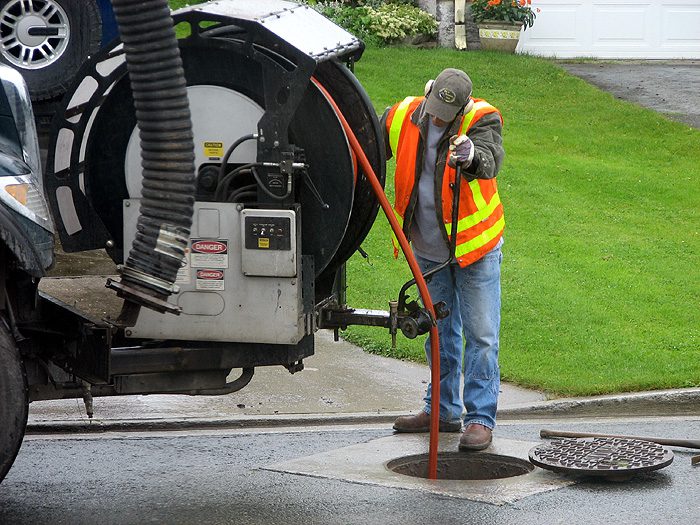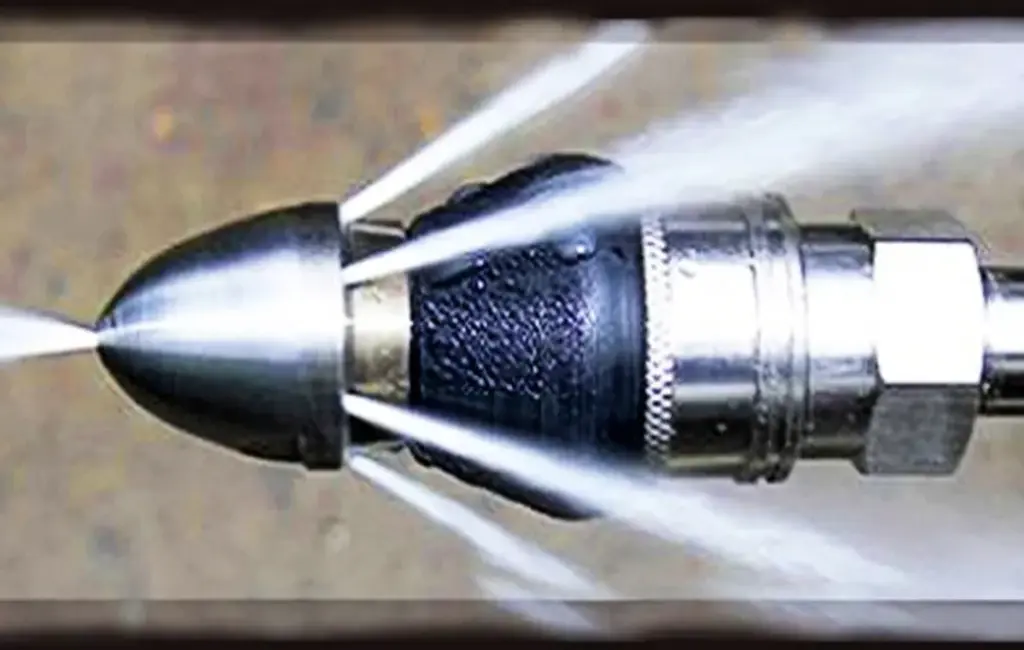What Is Hydro Jet Drain Cleaning? Get To Know Here
Got a stubborn clog that just won’t quit? Hydro jet drain cleaning might be your answer. It uses high-pressure water to blast through grease, sludge, and debris.
Quick, powerful, and thorough—this method gets your pipes flowing like new without harsh chemicals or major plumbing work.
What is Hydro Jet Drain Cleaning?
Hydro jet drain cleaning uses high-pressure water to clear stubborn clogs, ensuring pipes are fully cleaned without harsh chemicals or invasive methods.
Key Takeaways:
- Hydro jetting uses high-pressure water to clear tough clogs, including grease, sludge, and tree roots.
- It’s faster, cleaner, and more thorough than traditional drain cleaning methods like snaking.
- The process is generally safe for well-maintained pipes but may damage old, fragile pipes.
- Hydro jetting can prevent future clogs by clearing entire pipe lines and avoiding the need for frequent plumber visits.
- DIY hydro jetting is risky; always hire a professional.
How Hydro Jet Drain Cleaning Works

1. It’s basically a pressure washer for your pipes
Hydro jetting uses a super high-pressure stream of water to blast through whatever’s clogging your drains. We’re talking up to 4,000 PSI—strong enough to clear grease, gunk, roots, you name it.
2. The nozzle’s got the cheat code
A special nozzle is pushed down the drain line. It sprays water in every direction—forward to cut through blockages, backward to clean the pipe walls as it moves out. Think of it like power-washing your insides.
3. Clears it all, not just some
Unlike snaking, which only punches holes through clogs, hydro jetting wipes the whole pipe clean. No more sludge lining the walls. That means fewer problems later.
4. It’s quick, clean, and satisfying to watch
Once the jet’s in action, it only takes a few minutes to clear most lines. You don’t get your hands dirty, and your pipes get a deep clean. It’s basically a spa day for your plumbing.
Pro tip
It’s smart to get a camera inspection first. That way, you know the pipes can handle the pressure without cracking. No surprises, just clean flow.
Hydro Jetting vs. Traditional Drain Cleaning Methods
1. Old-school methods: snakes and chemicals
Traditional drain cleaning usually means using a drain snake or dumping harsh chemicals. Snakes break through clogs but don’t clear everything out. Chemicals? They might clear a bit but can wreck your pipes over time. That’s why many businesses now rely on grease interceptors service in Aventura to prevent buildup and maintain healthy plumbing systems without the damage caused by aggressive methods.
2. Hydro jetting: pressure with precision
Hydro jetting uses high-pressure water to blast away buildup. It clears the full diameter of the pipe, not just a path through the mess. Think of it like power washing your plumbing from the inside.
3. Which one’s better?
If you’re dealing with greasy sludge, roots, or years of grime, hydro jetting wins hands down. It’s cleaner, faster, and leaves pipes looking brand new. Snaking’s fine for small clogs, but it’s a band-aid, not a fix.
Bottom line?
Hydro jetting isn’t just stronger, it’s smarter. Less guesswork, more results. If you want your drains cleared, not just poked, this is the move.
When Should You Consider Hydro Jetting?

1. Your drains are moving slower than a Monday morning
If your sink takes forever to clear or your shower turns into a foot bath, it’s not just annoying—it’s a sign. A clog might be forming deeper in the line, and that’s where hydro jetting flexes.
2. You’re stuck in a cycle of repeat clogs
Cleared it last month, and now it’s back? That’s not normal. Basic snaking might be missing the gunk stuck to the pipe walls. Hydro jetting clears it like a fresh reset.
3. There’s a weird smell that won’t leave
A lingering funk from your drains? Could be grease, food, or build-up just chillin’ down there. A high-pressure flush knocks it out fast.
4. Tree roots crashed the party
Older homes with clay or cast iron pipes? Roots love ‘em. If you’ve had root problems before, hydro jetting can slice them out clean.
5. You’re buying or renovating a place
Before investing in a property, hit the reset button on the plumbing. It’s a smart way to avoid surprise repair costs later. Think of it as pipe pre-gaming.
Is Hydro Jetting Safe for All Pipes?
Short answer? Mostly, yes. But there’s a catch.
Hydro jetting works great on newer, sturdy pipes—think PVC or copper. It blasts out gunk without breaking a sweat. But if your plumbing’s old and cranky, it might not be the best move.
We’re talking fragile cast iron or corroded pipes from decades ago. That kind of wear doesn’t always vibe with high-pressure water. One hit and you could spring a leak—or worse.
The cheat code? Always get a camera inspection first. A quick peek inside tells you if your pipes can handle the pressure or need a gentler clean-up crew.
So yeah, hydro jetting’s safe… as long as your pipes aren’t falling apart behind the scenes.
Benefits of Hydro Jet Drain Cleaning
1. It clears everything, not just the obvious.
Hydro jetting doesn’t play favorites. Whether it’s grease, hair, sludge, or mystery gunk from 2003, it blasts it all. Snakes might poke a hole, but jets wipe the slate clean.
2. It’s low-key maintenance gold.
You’re not just unclogging a drain. You’re buying yourself peace and fewer plumber visits. Fewer surprises fewer stress sweats when the kitchen backs up mid-dinner party.
3. Zero harsh chemicals. Just high-pressure flex.
No weird fumes or toxic runoff. Just good old water pressure doing the dirty work. It’s safer for your pipes and the planet, so you can feel good while getting the grime gone.
4. It digs deeper—literally.
Hydro jets don’t just handle surface problems. They reach deeper into the line to break up long-standing buildup. Think of it like flossing, but for your pipes.
5. Fast, efficient, and kinda satisfying.
Once that hose goes in, it’s like watching years of nastiness vanish in minutes. It’s quick, it works, and you won’t have to think about it again anytime soon.
Bottom line? It’s like giving your drains a power wash and a pep talk.
Potential Risks and Limitations

1. It’s Not for Old Pipes
If your plumbing’s ancient or already struggling, hydro jetting might do more harm than good. The pressure can crack brittle or corroded pipes, turning a quick fix into a major headache. Before going full blast, have a pro inspect your lines.
2. It Doesn’t Fix Everything
Got tree roots punching through your pipes? Hydro jetting won’t magically seal that up. It clears blockages, not breaks. If there’s structural damage, you’ll need repair work, not just water pressure.
3. Operator Skill Matters
This isn’t a DIY job unless you’re into flooded kitchens. Too much pressure or bad aim can wreck your pipes or back up debris. Always roll with someone who knows their way around the equipment.
4. Short-Term Fix for Deeper Issues
If your drains keep clogging every few weeks, the real issue might be bigger than grease buildup. Hydro jetting can clear it temporarily, but it’s not a cure-all. Get to the root cause.
Cost of Hydro Jetting Services
1. What you’re looking at price-wise
Hydro jetting typically runs between $300 to $600. That said, prices can climb if your lines are extra long or seriously clogged. Think restaurant kitchens or decades-old plumbing.
2. Why the price swings
Cost depends on how bad your blockage is, where the line sits, and how accessible it is. A quick cleanout? Cheaper. Digging through tree roots? That’s more time, more dough.
3. Is it worth the spend?
Totally. Compared to multiple plumber visits or pipe replacements, jetting is like hitting the reset button on your drains. You pay once, your pipes breathe easy for months. Maybe even years.
Pro tip
Ask your plumber if the cost includes a camera inspection. Some throw it in, others charge extra. But it’s clutch for making sure the job’s actually done.
What to Expect During a Hydro Jetting Appointment
1. Show up, gear up, clean up
First, your plumber will check the line with a camera. Think of it like a drain selfie—just to see what’s going on inside. They’ll look for blockages, buildup, or any surprise tree roots throwing a party down there.
2. The waterworks begin
Once they’ve scoped the scene, it’s go time. A high-pressure hose gets fed into your line and blasts water in all directions. It’s not a gentle rinse—it’s more like pressure washing your pipes back to their glory days.
3. Wrap-up and peace of mind
After the cleanout, they’ll check again to make sure everything’s flowing like it should. You’ll get the rundown, maybe even a before-and-after video. Satisfaction? Basically guaranteed.
Is DIY Hydro Jetting a Good Idea?
Short answer? Not really. Hydro jetting isn’t your average YouTube fix-it project. You’re dealing with high-pressure water that can wreck pipes if you don’t know what you’re doing.
One wrong move and you’re not clearing a clog—you’re calling for full-blown repairs. Pros have the gear, the grip, and the gut-check to handle it clean.

If your drain’s giving attitude, grab a plunger. If it’s full-blown stubborn? Time to call someone with a license and a jet.
Maintenance Tips to Avoid Future Clogs
1. Don’t treat your drain like a trash can
Grease, food scraps, coffee grounds—keep ’em out. That stuff builds up fast and turns your pipes into slow lanes.
2. Hot water is your homie
Run hot water down the sink after each use. It helps flush out little bits before they get clingy.
3. Skip the store-bought clog gimmicks
Those chemical cleaners? They’re harsh and mostly hype. Go with regular pro cleanings instead—your pipes will thank you.
Frequently Asked Questions
1. Does hydro jetting damage old pipes?
If your pipes are already fragile or cracked, hydro jetting might be too much. But for solid, well-maintained lines, it’s safe and super effective.
2. How often should I get hydro jet drain cleaning?
For homes, once a year usually does the trick. Businesses like restaurants? You’ll want to do it more often to keep grease in check.
3. Can I do hydro jetting myself?
Short answer—don’t. The pressure’s no joke, and one wrong move can turn a clog into a full-blown plumbing emergency.
Conclusion
Hydro jet drain cleaning isn’t just hype. It’s the real deal for blasting through buildup without wrecking your pipes.
If your drains keep acting up, this could be your cheat code. It’s quick, deep-cleaning, and way less invasive than digging around.
For stubborn clogs and long-term flow, hydro jetting brings the pressure—in a good way.
